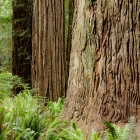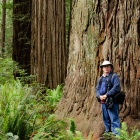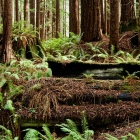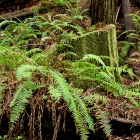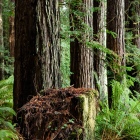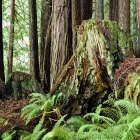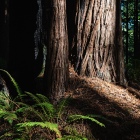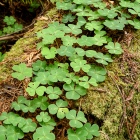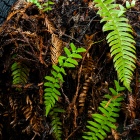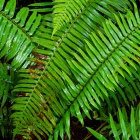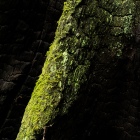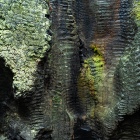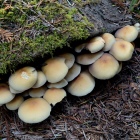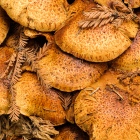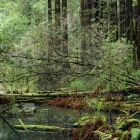(Click on any thumbnail to expand the image to full-size. You can browse all full-size images or start a slideshow.)
The Coast Redwoods, sequoia sempervirens, are the world’s tallest trees. They grow in a 450-mile / 725-km long strip of the California coast from Big Sur to the very southwest corner of Oregon. Because they derive most of their moisture from coastal fog, the redwoods are largely confined to a strip of land within about 25-miles / 40-km of the ocean. The tallest known living redwood measures 379 ft / 115 m high and is located in the Redwood National Park, north of Eureka, California. The Giant Sequoia tree is a cousin of the Coast Redwood. While more massive, the Giant Sequoia is not as tall at the Coast Redwood. The Sequoia grows only in the Sierra Nevada of California. Both species are very long-lived with many examples of trees living well over 1,000 years of age.
Prized for its long, straight grain, few knots and resistance to insects and decay, redwood has been sought for construction. Over 95% of the redwoods that existed when Western settlers arrived in California have been cut for lumber. Indeed, the city of San Francisco was built and then rebuilt (post 1906 earthquake) with redwood timber from the north coast. Fortunately, a series of California State Parks and a U.S. National Park protect some of the remaining original growth groves. One of my favorite old-growth groves is the Stout Grove, in the Jedediah Smith Redwoods State Park in Del Norte County. This grove, located in the alluvial flood plain of the still wild Smith River, provides prime habitat for redwood seedlings to sprout and grow. The first two images in the gallery provide a glimpse of this grove and, for scale reference, a 70 inch / 178 cm tall photographer. Original growth groves are magnificent forests to visit. The giant trees form a canopy that almost totally blocks direct sunlight from the forest floor. The first branches of these trees are usually at least 100 ft / 30 m above the ground. The giants have won the competition with other species and less vigorous redwoods.
We are fortunate to live in redwood country. But our area was a prime source of redwood lumber and nearly all the original growth has been cut. A section of the redwood forest, a short walk from my home, became a favorite spot to visit and a challenge to photograph during the 2020 – 2021 COVID-19 pandemic. Local experts, matching growth ring patterns from stumps in this tract with those in recently logged tracts nearby, estimate our subject forest was logged in the 1890s, or about 125 years ago. Visit the tract many times and one begins to understand that the dynamics of regrowth are still very active. While many regrowing redwoods are over 100 ft / 30 m tall, some perhaps 150 ft / 45 m, the redwoods continue to compete with some hearty Douglas Fir trees. The redwood canopy does not totally block direct sun from the forest floor and species other than ferns do grow though slowly. Redwoods reproduce both by seed and clonally. Many stumps from the 1890s logging still have six or more clones sprouting from them and fighting for light and water. In the end, at most one will dominate. The panorama of the forest, the third image in the gallery, shows multiple stumps, each with many clones competing.
This forest tract is located along the west bank of the Gualala River. The river’s flood plain is prime territory for seedlings to take root and grow vigorously given the added sunlight available owing to the river’s break in the forest. Indeed some of the largest regrown trees are along the river’s bank yet even these trees are no more than 4 to 5 ft / about 1.5 m in diameter. The fifth image in the gallery shows one of the more successful regrowing trees in comparison to a nearby stump from the logging.
The Gualala River flows along the infamous San Andreas fault. The fault ruptured in the 1906 earthquake. In our area about 100 mi / 160 km north of the Golden Gate the Pacific plate, roughly the west bank of the river, shifted north 15 to 18 ft (4.5 to 5.5 m) relative to the North American plate. That shift cut-off the beds of streams that flowed from the ridge to the river and the water now accumulates in sag ponds in the forest. The final image is of one of the sag ponds in the forest during the winter rainy season.
So, the competition for light, moisture and nutrients continues in this recovering redwood forest. While we are happy this particular tract will not be harvested, we should walk away with a lesson about the centuries required to fully regrow a redwood forest. Think, think and think again before harvesting a redwood tree.
Want to know more about the redwoods? I was surprised to find relatively few good references beyond those in typical handbooks. My best reference has been:
- John Evarts & Marjorie Popper, editors, Coast Redwood: A Natural and Cultural History, Cachuma Press, Los Olivos California, 2001. ISBN 0-9628505-5-1. This book is out of print but readily available from the usual sources of quality used books.

